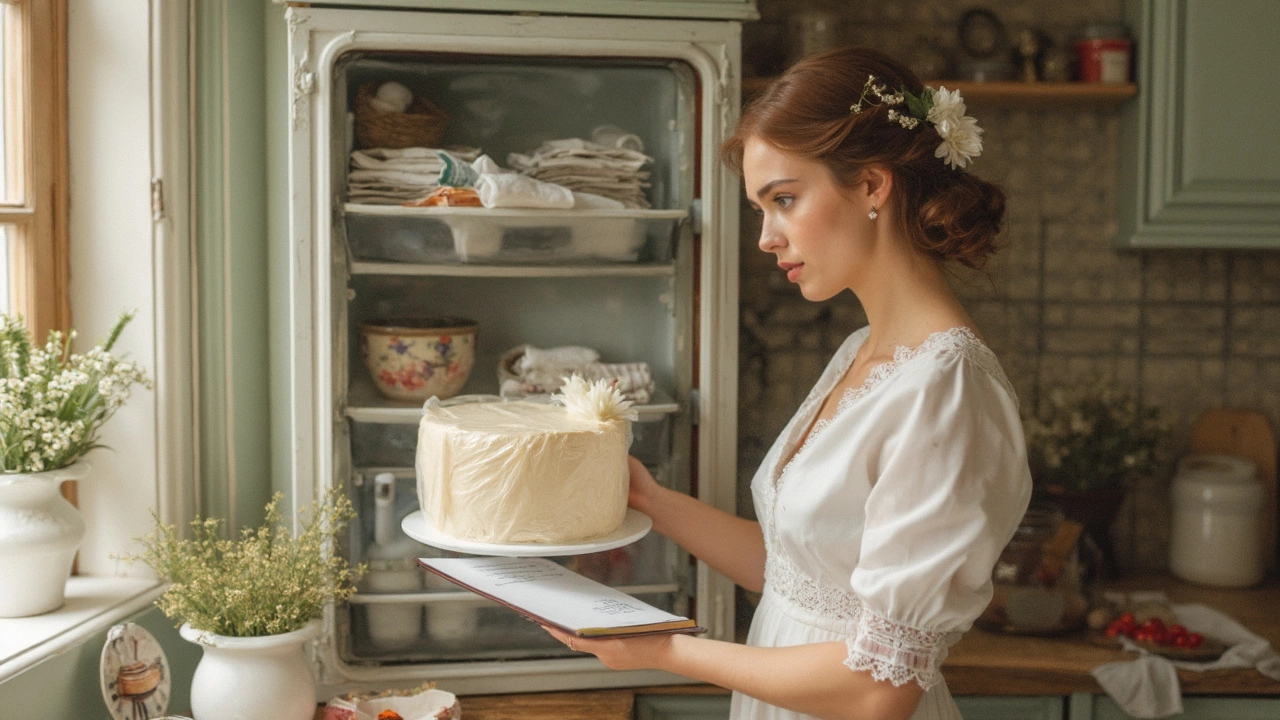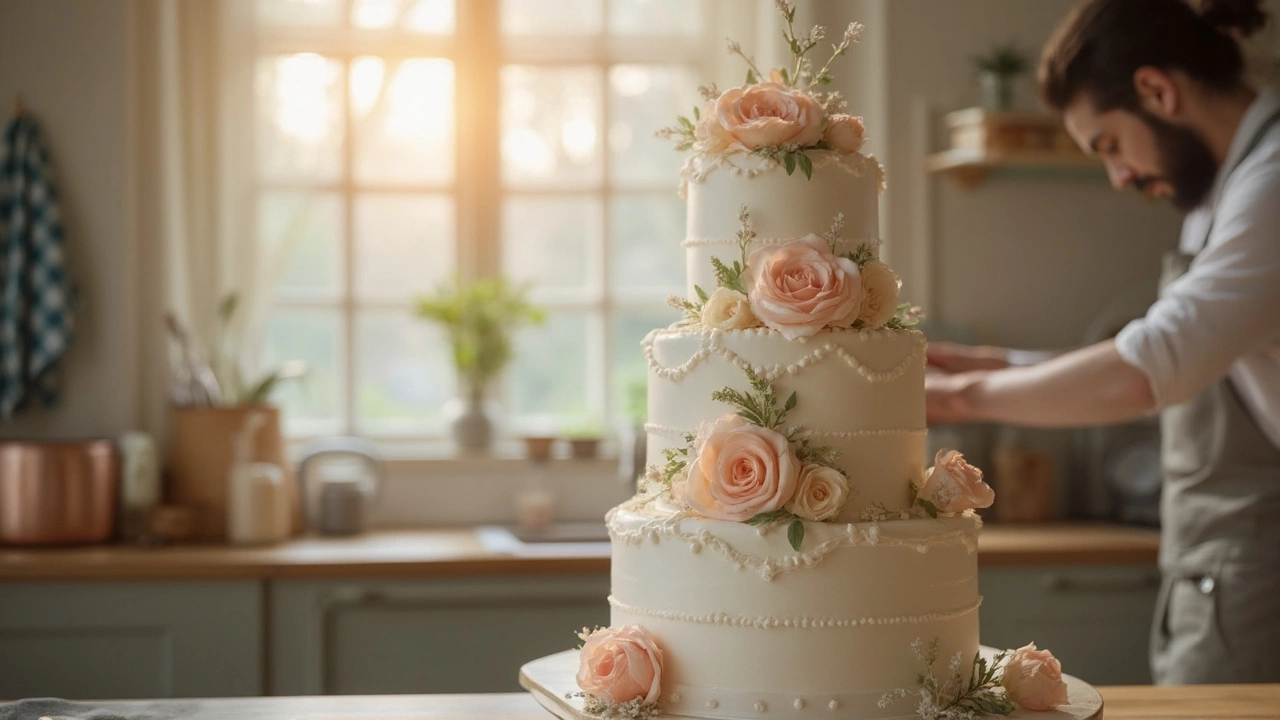If you’re sweating over your cake timeline, you’re not alone. The idea of stacking a wedding cake the night before is tempting—you want everything to go smoothly, and who needs the stress on the big day?
The good news: yes, you can stack a wedding cake the night before. But hold up. Whether you should really depends on a few key things: your cake’s fillings, your storage situation, and a bit of basic cake physics.
The professionals usually stack their cakes ahead of time, but they don’t just wing it. They pick sturdy fillings that won’t squish or ooze overnight. Think ganache or firm buttercream instead of whipped cream or fresh berries. Spongy or very soft cakes? That’s a potential nightmare when stacked early—they can buckle under the weight.
Your fridge matters, too. Got a reliable, roomy fridge? Great, you’re set. Humidity and heat spell disaster, making fondant sticky and buttercream weepy. If you’re going for the night-before approach, you’ll want a cool, steady environment—no exceptions.
- Realities of Early Cake Stacking
- The Science Behind Cake Structure and Fillings
- How Weather and Storage Affect Cake Stability
- Step-by-Step Safe Stacking Tips
Realities of Early Cake Stacking
Stacking a wedding cake the night before sounds like a solid plan—less to worry about on the big day, right? But this move isn’t just about saving time. The truth is, how your cake survives overnight depends on facts you can’t ignore.
First, most professional wedding cake makers do assemble at least partially ahead of time. It makes transport easier, gives buttercream a chance to set, and helps the structure hold. But they don’t just stack and hope for the best. They think through every layer like a game of Jenga. Dowels and cake boards are musts—not optional. Without these, you risk serious leaning, bulging, or collapse, especially with heavy fondant or taller cakes.
Not all cakes are equal when it comes to early stacking. Here’s what you’re up against:
- If your cake has soft fillings (like whipped cream, mousse, or fresh berries), you’re flirting with disaster. These fillings can start to ooze or break down, making the whole stack unstable by morning.
- Got a naked cake or one with exposed edges? These dry out faster. Early stacking, plus a night in the fridge, can leave it less than fresh.
- Cakes covered in fondant usually do fine overnight, but fondant sweats if it comes out of a cold fridge into a humid room. That means sticky, shiny fondant that’s tough to decorate or move.
People ask if refrigeration changes the cake. The short answer: sometimes. Butter-based cakes firm up in the fridge, which is actually helpful for transport and stacking. Sponge cakes, though, can get dense or rubbery if they sit too long in the cold.
| Factor | Better for Night Before Stacking? |
|---|---|
| Buttercream-filled, fondant-covered | Yes |
| Fresh fruit or whipped cream | No |
| Dense, sturdy cake (like mud cake) | Yes |
| Soft sponge | Maybe, but risky |
If you’re thinking about a last-minute stack, know there’s a reason the big cake disasters go viral: it’s that real. Always line up your cake boards, use the right number of dowels, and understand your fridge before committing to stacking ahead of time.
The Science Behind Cake Structure and Fillings
Building a tall, gorgeous wedding cake isn’t just about looks—it’s really about structure. If you’re stacking a cake the night before, this is where things can go sideways if you’re not careful. The pros plan with science in mind, not just decoration.
The main thing is support. A tiered wedding cake stacking job means each layer needs to carry not only its own weight but whatever’s stacked above it. That’s why every pro uses dowels or straws inside each lower layer—think of them as little columns holding up the world. Skip this, and you’re asking for a doomed cake collapse.
Let’s talk cake type. Dense cakes, like pound cake or mud cake, hold up best. Super moist or super soft cakes like chiffon are a lot more unstable under pressure. So if you want your cake to survive the night, stick to recipes that don’t deflate or turn to mush with weight.
The filling is just as important. Soft fillings like whipped cream, custard, pastry cream, or jams are risky for overnight stacking. They shift, seep, and can even ferment or go sour. Instead, look for options that stay solid and act as glue between layers—think American buttercream, ganache, or Swiss meringue. Here’s a quick glance at which fillings work overnight:
| Filling Type | Safe for Overnight Stacking? | Notes |
|---|---|---|
| Buttercream (American/Swiss) | Yes | Firm and stable |
| Ganache | Yes | Sets hard, supports weight |
| Whipped Cream | No | Can deflate or spoil |
| Custard/Pastry Cream | No | Soft, high risk for slipping |
| Jam/Fruit Fillings | Maybe | Needs a barrier (like buttercream dam) |
Another little-known tip: always use cake boards under each tier, even for small cakes. They help spread weight, keep layers separate and make it easier to move the cake around without squishing anything.
One last thing, notice how pros run a ring of buttercream (called a "dam") around the edge of each layer before adding their filling. This keeps squishier fillings from leaking out or bulging. It takes just a few seconds but can save your design, especially if the cake will sit assembled overnight in the wedding cake timeline.

How Weather and Storage Affect Cake Stability
Let’s get real: cake stability is at the mercy of both weather and storage. If you’re stacking the night before, ignore these at your own risk—especially in summer or anywhere humidity sneaks into the kitchen.
Humidity is the big villain here. Moisture in the air makes fondant sticky and causes buttercream to soften or melt—so that pretty cake can start looking like a sad pancake. If you’re in a hot, humid area, keeping your wedding cake stacking timeline tight is even more important. Pro bakers often use dehumidifiers or crank up the AC to keep the air dry and cool when working late into the night.
Here’s what else to watch for:
- Heat: Warm air = soft buttercream, droopy tiers, and a cake that’s tricky to rescue. Always keep cakes stored between 36-40°F (2-4°C) once assembled, if possible.
- Fridge Size: A jammed fridge squishes decorations and won’t cool evenly. You need space around the cake for air to circulate, so clear out leftovers ahead of time.
- Condensation: Pulling a cake from a cold fridge straight into warm air causes water droplets on the surface, making fondant sticky or colors run. Let it come to room temp gradually—in the box if you can—to avoid this.
- Wind and Sunlight: Outdoor weddings? Even shade can heat up in direct sun, and a breeze can dry out decorations or topple precariously stacked tiers.
Let’s look at what heat and humidity really do to a typical wedding cake:
| Weather | What Happens to Cake |
|---|---|
| High humidity | Fondant sweats, buttercream softens, fillings ooze |
| High heat | Buttercream melts, structure weakens, tiers shift |
| Cold storage, sudden warmth | Condensation forms, colors bleed, surface turns sticky |
Safe storage means keeping the cake chilled but not frozen, away from direct air flow. Always store in a box to prevent fridge smells and unexpected drafts. If you’re moving the cake, plan ahead: transport in an air-conditioned car, never in the trunk or exposed to sunlight, and always keep the cake level.
The takeaway? The smarter you are about wedding cake timeline and storage, the better your stacked cake looks (and survives) at showtime. A little planning here is way less stressful than an emergency cake repair!”
Step-by-Step Safe Stacking Tips
Let’s cut straight to the chase—no one wants to wake up to a lopsided or sagging wedding cake. Here’s how the pros actually handle wedding cake stacking the night before, step by step:
- Chill Your Cakes First: A cold cake is your friend. Before stacking, pop each tier in the fridge for at least an hour. This firms up the cake and filling, making handling way easier and reducing dents or cracks.
- Prep Boards and Dowels: Every tier needs its own cake board. Slide a board under each layer (cut to fit, not sticking out). Use food-safe dowels or sturdy straws in every tier except the top one. For a standard 8-inch tier, use about four to six dowels spaced evenly in a small circle. This holds the weight and prevents sinking.
- Stack on a Level Surface: Place the bottom tier on your final display base or drum. Gently center the next tier on top, watching those dowels. Keep going, working from bottom to top. A small offset spatula helps slide them into place without wrecking the edges.
- Central Support for Tall Cakes: For cakes three tiers and up, drive a sharpened dowel through the center of all tiers. This basically acts as a spine, so things stay put even if someone gives the table a nudge.
- Insulate if Needed: If your fridge is super cold or smells like last night’s leftovers, wrap the stacked cake in plastic wrap, but avoid touching the decorations. This protects both flavor and finish.
- Final Touches Last Minute: Don’t risk fondant decorations wilting or flowers sagging. Add delicate bits and fresh blooms in the morning, just before display, not the night before.
Here’s a quick at-a-glance chart for dowel use in different tier sizes:
| Tier Size | Recommended Dowels |
|---|---|
| 6-inch | 3-4 |
| 8-inch | 4-6 |
| 10-inch | 6-8 |
Storing your assembled cake in a reliable fridge is a non-negotiable. If there’s humidity, keep the cake in its box; this helps avoid a sticky mess. Use these cake assembly tips and you’ll cut way down on stress, whether you’re going pro or keeping it DIY.

